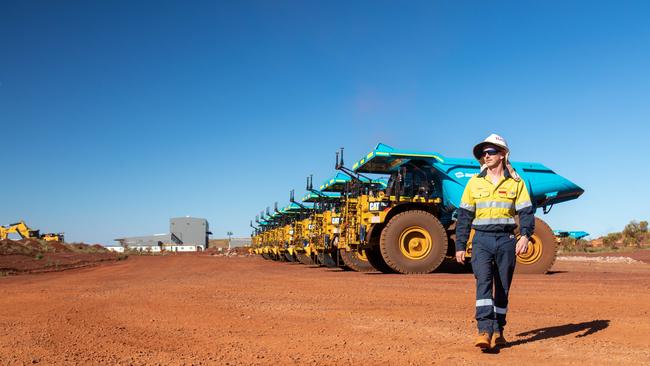Rio Tinto considers major shift in clean energy strategy
Rio Tinto’s plans to spend $US7.5bn on carbon reduction have been questioned by analysts, but the company is looking for ways to shift the spending off its own balance sheet.

Rio Tinto is considering a significant shift in the renewable energy strategy at its West Australian iron ore operations, with the iron ore major looking at ways to cut its own capital spending by outsourcing the development and operation of the one gigawatt-worth of renewable energy plants needed to power its Pilbara mines.
Rio has previously flagged the desire to own and operate its own renewable energy generators in the Pilbara and, while a new strategy has not yet been formally adopted, The Australian understands the company has taken market soundings to gauge interest in the potential outsourcing of some existing near-term renewable energy projects.
The mining giant is considering its options to bring in specialist renewable energy developers to build and own the other major renewable energy installations needed to reach long-term decarbonisation goals.
Rio has previously committed to spending $US600m ($878m) on 234 megawatts of solar and 200 megawatt hours of storage in the Pilbara between 2023 and 2026, announcing a plan in November 2022 in an effort to meet its 2025 target of slashing 15 per cent off carbon emissions and cutting 30 per cent of its current natural gas use.
Those plans include 34MW of solar at its Rio’s new Gudai-Darri mine, a 100MW solar farm near Karratha, and a second major solar installation at an undisclosed location.
By the end of the decade Rio says it will need to build up to 1GW of renewable energy generation to meet its goal of halving carbon emissions by 2030.
Rio has not put a cost on the total rollout of Pilbara renewable energy plans, but the company’s overall decarbonisation capital spending plan – about $US7.5bn by 2030 – has raised flags with financial analysts over concerns it could eventually affect shareholder returns as commodity prices soften.

While saying there will be no backdown on the company’s decarbonisation effort, late last year Rio chairman Dominic Barton said the company was facing pressure over its spending plans, amid growing investor concern over future returns.
When Rio outlined its decarbonisation plans at its annual London investor day in November 2022, chief technical officer Mark Davies said the company wanted to own its own Pilbara generation rather than – as it had for its Queensland alumina and aluminium operations – looking to do renewable energy power purchase agreements with external power providers.
“It makes sense for us to invest to develop renewables in the Pilbara as we own much of the infrastructure and operate the grid as part of our integrated operations,” he said.
“In other locations, power purchase agreements are a better option for us as other investors focused on renewables can develop large solutions at a more attractive cost of capital, offering us real operating cost savings.”
Rio’s short-term plans are already in deep trouble, however, with the company warning in Wednesday’s June quarter production report that its goal of cutting scope 1 and 2 emissions by 15 per cent by 2025 was at risk due to a combination of tight global supply chains and delayed approvals.
“Activity across our global decarbonisation portfolio continues to accelerate. However, physical delivery of renewables, diesel replacement and process heat abatement has not progressed as fast as we would like,” the company said. “Delays have arisen due to a range of factors including engineering and construction timelines, securing approvals and the need to carefully integrate our ambitions with the needs of our local communities and stakeholder groups. This particularly challenges our near-term objective in 2025 where we have limited time to make adjustments to physical projects.”
Sources say that Rio is considering whether those plans can be put back on track by bringing in specialist renewable energy developers. The additional generation capacity needed by the end of the decade is the most likely candidate for outsourcing under a revised strategy.
Set against Rio’s desire to reduce the capital spending on its own balance sheet is the need to ensure security of supply, sources say. Unlike BHP, which recently said it pinned its Pilbara decarbonisation hopes on a shared generation and transmission deal between major iron ore producers, Rio is reluctant to tie its Pilbara operations to energy generation and transmission controlled by rival iron ore producers.
Rio Tinto shares closed up 42c at $116.43 on Thursday.



